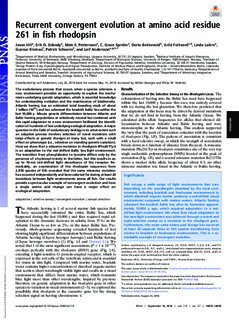| dc.contributor.author | Hill, Jason | |
| dc.contributor.author | Enbody, Erik D. | |
| dc.contributor.author | Pettersson, Mats E. | |
| dc.contributor.author | Sprehn, C. Grace | |
| dc.contributor.author | Bekkevold, Dorte | |
| dc.contributor.author | Folkvord, Arild | |
| dc.contributor.author | Laikre, Linda | |
| dc.contributor.author | Kleinau, Gunnar | |
| dc.contributor.author | Scheerer, Patrick | |
| dc.contributor.author | Andersson, Leif | |
| dc.date.accessioned | 2020-01-16T08:09:20Z | |
| dc.date.available | 2020-01-16T08:09:20Z | |
| dc.date.created | 2019-09-30T13:59:43Z | |
| dc.date.issued | 2019 | |
| dc.identifier.citation | Proceedings of the National Academy of Sciences of the United States of America. 2019, 116 (37), 18473-18478. | nb_NO |
| dc.identifier.issn | 0027-8424 | |
| dc.identifier.uri | http://hdl.handle.net/11250/2636545 | |
| dc.description.abstract | The evolutionary process that occurs when a species colonizes a new environment provides an opportunity to explore the mechanisms underlying genetic adaptation, which is essential knowledge for understanding evolution and the maintenance of biodiversity. Atlantic herring has an estimated total breeding stock of about 1 trillion (1012) and has colonized the brackish Baltic Sea within the last 10,000 y. Minute genetic differentiation between Atlantic and Baltic herring populations at selectively neutral loci combined with this rapid adaptation to a new environment facilitated the identification of hundreds of loci underlying ecological adaptation. A major question in the field of evolutionary biology is to what extent such an adaptive process involves selection of novel mutations with large effects or genetic changes at many loci, each with a small effect on phenotype (i.e., selection on standing genetic variation). Here we show that a missense mutation in rhodopsin (Phe261Tyr) is an adaptation to the red-shifted Baltic Sea light environment. The transition from phenylalanine to tyrosine differs only by the presence of a hydroxyl moiety in the latter, but this results in an up to 10-nm red-shifted light absorbance of the receptor. Remarkably, an examination of the rhodopsin sequences from 2,056 species of fish revealed that the same missense mutation has occurred independently and been selected for during at least 20 transitions between light environments across all fish. Our results provide a spectacular example of convergent evolution and how a single amino acid change can have a major effect on ecological adaptation. | nb_NO |
| dc.language.iso | eng | nb_NO |
| dc.title | Recurrent convergent evolution at amino acid residue 261 in fish rhodopsin | nb_NO |
| dc.type | Journal article | nb_NO |
| dc.type | Peer reviewed | nb_NO |
| dc.description.version | publishedVersion | nb_NO |
| dc.source.pagenumber | 18473-18478 | nb_NO |
| dc.source.volume | 116 | nb_NO |
| dc.source.journal | Proceedings of the National Academy of Sciences of the United States of America | nb_NO |
| dc.source.issue | 37 | nb_NO |
| dc.identifier.doi | 10.1073/pnas.1908332116 | |
| dc.identifier.cristin | 1731523 | |
| dc.relation.project | Norges forskningsråd: 254774 | nb_NO |
| cristin.unitcode | 7431,21,0,0 | |
| cristin.unitname | Pelagisk fisk | |
| cristin.ispublished | true | |
| cristin.fulltext | original | |
| cristin.qualitycode | 2 | |
